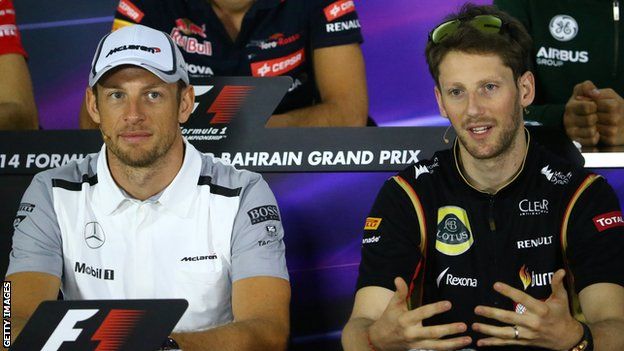Romain Grosjean replaces Jenson Button at Grand Prix Drivers' Association
- Published

Romain Grosjean has become a director of the Grand Prix Drivers' Association (GPDA)
Frenchman Romain Grosjean has replaced Jenson Button as a director of the Grand Prix Drivers' Association.
The Haas driver joins Ferrari's Sebastian Vettel and chairman Alexander Wurz in the leading roles after Button stepped down following his decision not to race in 2017.
Grosjean, 31, said: "I am proud to have been elected by my peers.
"We race drivers don't always hold the same opinion but we are united in wanting the best for our sport."
Grosjean's appointment means he will be campaigning officially for the introduction of additional head protection in F1, something to which he is personally opposed. The vast majority of drivers are in favour of such a system.
Grosjean said at the Russian Grand Prix last weekend that he was "not a fan" of either the 'halo' system - a metal structure that arches over the driver's shoulders and meets in a central point at the front of the cockpit - which has been proved to work but is meeting opposition, or the new 'shield' that was last week prioritised by governing body the FIA.
The FIA is committed to introducing additional head protection in 2018 but time is running out.
The halo, which has been extensively tested and proved to work, is unpopular, and the shield is still in its infancy and will not run on track until September - almost certainly too late for it to be adopted next season.
How will Grosjean do it?
Grosjean has already been active in pushing for additional head protection as a member of the GPDA, despite his own feelings.
BBC Sport has been told that at a meeting between the drivers and the new bosses of F1, chairman Chase Carey and sporting boss Ross Brawn sought close co-operation with the drivers on future developments in the sport.
Grosjean himself pointed out to Carey and Brawn they should use the GPDA as the body they dealt with because it represented the drivers' collective opinion, free of influence by the teams on political issues.
And Wurz backs the idea of debates and differing opinions so the drivers can have constructive conversations that establish a majority opinion.
Where does the GPDA stand on head protection?
The proposed shield will be at a shallower angle than the aeroscreen trialled by Red Bull last season
Head protection is just one small part of the GPDA's work in F1.
It also:
supports general ongoing safety development, not just because it saves lives but also because it ensures the cars can continue to be fast and test the drivers to their limits;
believes that safety should be the sole responsibility of the FIA and not be affected by political issues; and
campaigns for changes that it believes would improve the sport for spectators.
But Wurz said he feared the debate over head protection had been politicised.
"Drivers prefer to support F1, and that means some topics should not be debated in the media, because safety should at no point become a political matter, as the halo has become," Wurz said.
"This comment is not about whether the halo is the right or wrong thing to do, but about the general process of developing a new safety device in F1."
The halo was initially developed by Mercedes, and was followed up by the FIA and the teams with the aim of reducing the risk of head injuries.
But the debate has widened into whether it is the right approach philosophically for F1.
It was initially slated for introduction in 2017 but was delayed by a year so further tests could be carried out. These were all passed successfully but now the shield system has been given priority and some insiders suspect that a move is being made behind the scenes to delay head protection again.
What about other issues?
The new regulations in F1 have made the cars bigger and faster
Wurz said the GPDA backed the direction F1 had taken in 2017, with new rules producing faster, more demanding cars.
The drivers were instrumental in campaigning for the introduction of tyres on which drivers could push hard for many laps at a time, replacing the previous design which needed careful management.
He added that the GPDA was also supportive of Brawn's desire to research new aerodynamic rules that would allow cars to follow each other more closely, and of the general direction of F1, as laid out by Carey to the drivers in meetings since the new owners took over in January.
- Published30 April 2017
- Published30 April 2017
- Published30 April 2017
- Published25 April 2017
- Published30 April 2017